Healthcare Informatics: Roles, Connected Health, and Public Health
VerifiedAdded on 2023/04/21
|9
|2098
|477
Report
AI Summary
This report provides a comprehensive overview of the future of healthcare informatics. It begins by introducing the field and emphasizing the pivotal role of technology in modern healthcare. The report delves into the current and future roles of the informatics nurse, highlighting their responsibilities in data management, risk assessment, and the implementation of information technology. It then explores connected health, examining its applications through examples, benefits, and drawbacks. The analysis extends to the impact of informatics on public health, showcasing how it aids in disease awareness, diagnosis, and community communication. The report concludes by summarizing the key findings, emphasizing the importance of informatics in enhancing healthcare delivery and patient outcomes, while also mentioning challenges like data privacy.
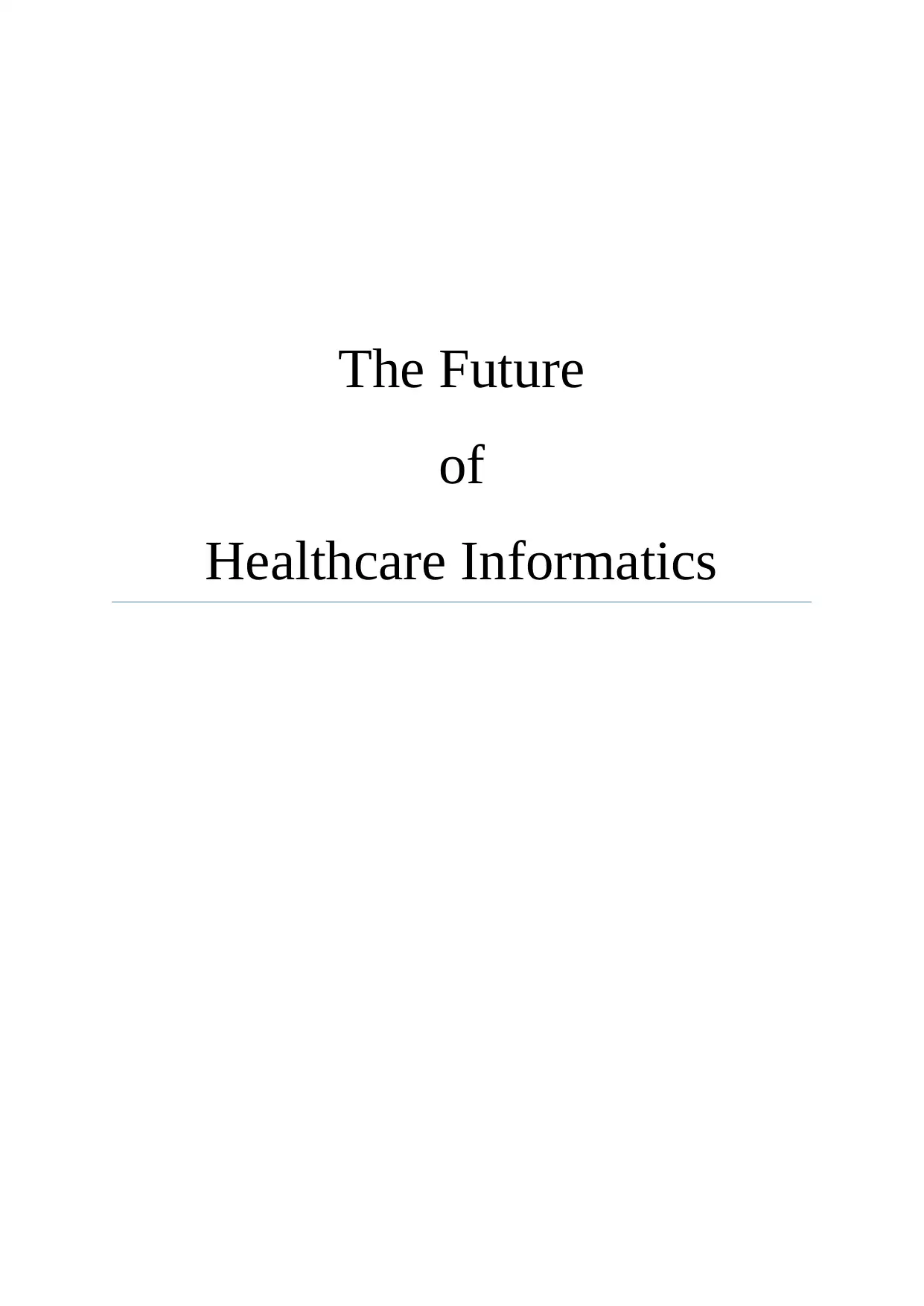
The Future
of
Healthcare Informatics
of
Healthcare Informatics
Paraphrase This Document
Need a fresh take? Get an instant paraphrase of this document with our AI Paraphraser
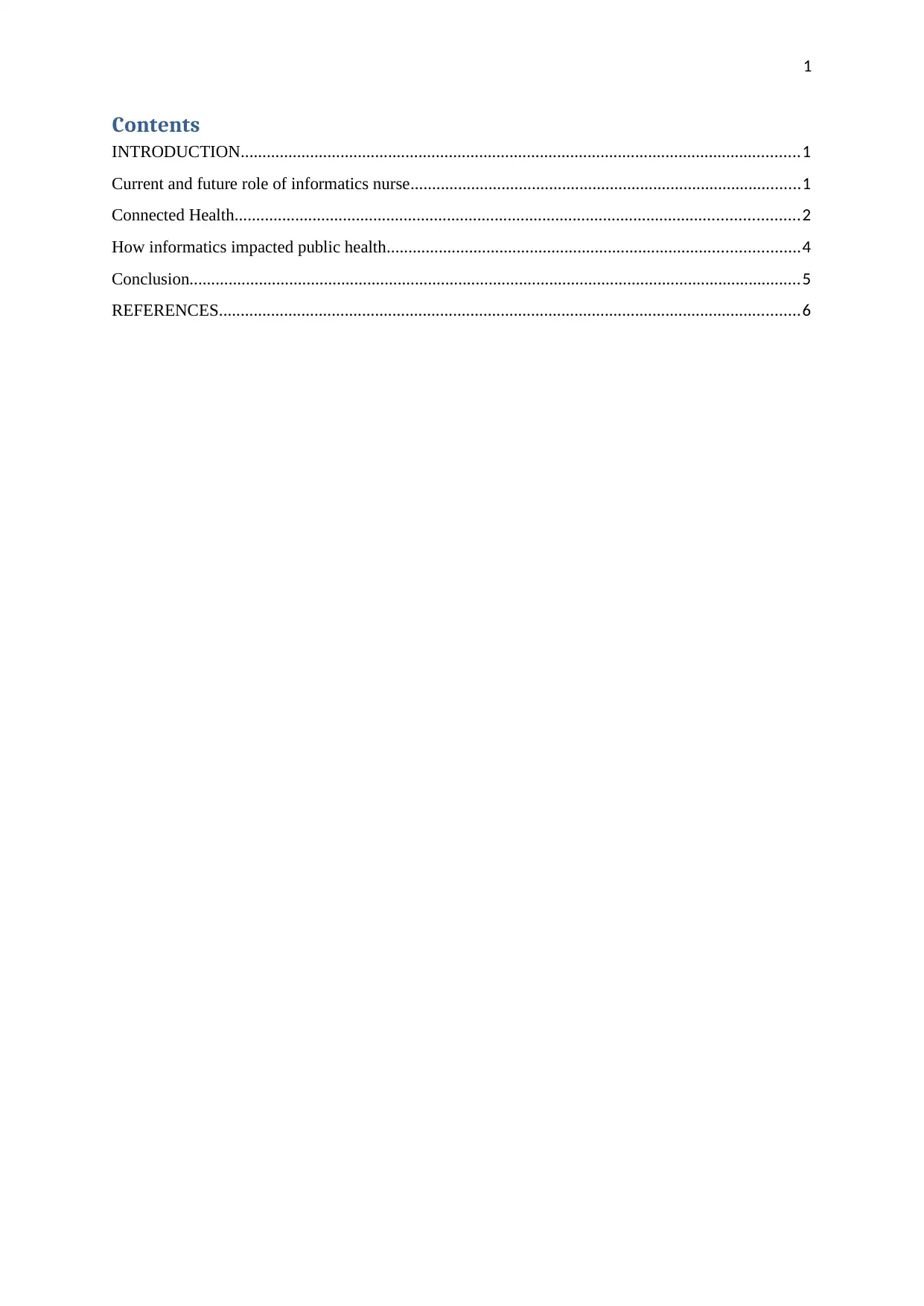
1
Contents
INTRODUCTION.................................................................................................................................1
Current and future role of informatics nurse..........................................................................................1
Connected Health..................................................................................................................................2
How informatics impacted public health...............................................................................................4
Conclusion.............................................................................................................................................5
REFERENCES......................................................................................................................................6
Contents
INTRODUCTION.................................................................................................................................1
Current and future role of informatics nurse..........................................................................................1
Connected Health..................................................................................................................................2
How informatics impacted public health...............................................................................................4
Conclusion.............................................................................................................................................5
REFERENCES......................................................................................................................................6
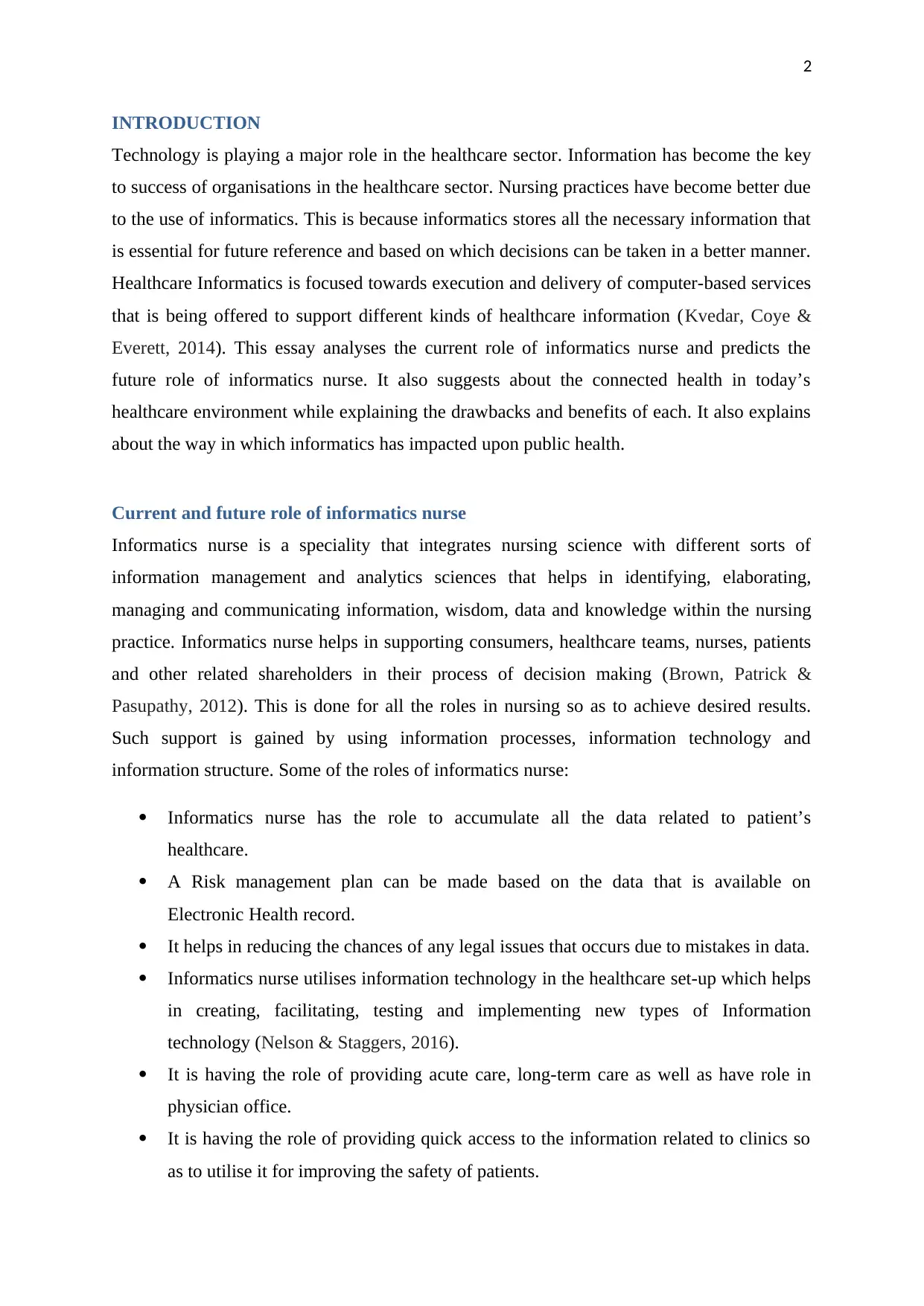
2
INTRODUCTION
Technology is playing a major role in the healthcare sector. Information has become the key
to success of organisations in the healthcare sector. Nursing practices have become better due
to the use of informatics. This is because informatics stores all the necessary information that
is essential for future reference and based on which decisions can be taken in a better manner.
Healthcare Informatics is focused towards execution and delivery of computer-based services
that is being offered to support different kinds of healthcare information (Kvedar, Coye &
Everett, 2014). This essay analyses the current role of informatics nurse and predicts the
future role of informatics nurse. It also suggests about the connected health in today’s
healthcare environment while explaining the drawbacks and benefits of each. It also explains
about the way in which informatics has impacted upon public health.
Current and future role of informatics nurse
Informatics nurse is a speciality that integrates nursing science with different sorts of
information management and analytics sciences that helps in identifying, elaborating,
managing and communicating information, wisdom, data and knowledge within the nursing
practice. Informatics nurse helps in supporting consumers, healthcare teams, nurses, patients
and other related shareholders in their process of decision making (Brown, Patrick &
Pasupathy, 2012). This is done for all the roles in nursing so as to achieve desired results.
Such support is gained by using information processes, information technology and
information structure. Some of the roles of informatics nurse:
Informatics nurse has the role to accumulate all the data related to patient’s
healthcare.
A Risk management plan can be made based on the data that is available on
Electronic Health record.
It helps in reducing the chances of any legal issues that occurs due to mistakes in data.
Informatics nurse utilises information technology in the healthcare set-up which helps
in creating, facilitating, testing and implementing new types of Information
technology (Nelson & Staggers, 2016).
It is having the role of providing acute care, long-term care as well as have role in
physician office.
It is having the role of providing quick access to the information related to clinics so
as to utilise it for improving the safety of patients.
INTRODUCTION
Technology is playing a major role in the healthcare sector. Information has become the key
to success of organisations in the healthcare sector. Nursing practices have become better due
to the use of informatics. This is because informatics stores all the necessary information that
is essential for future reference and based on which decisions can be taken in a better manner.
Healthcare Informatics is focused towards execution and delivery of computer-based services
that is being offered to support different kinds of healthcare information (Kvedar, Coye &
Everett, 2014). This essay analyses the current role of informatics nurse and predicts the
future role of informatics nurse. It also suggests about the connected health in today’s
healthcare environment while explaining the drawbacks and benefits of each. It also explains
about the way in which informatics has impacted upon public health.
Current and future role of informatics nurse
Informatics nurse is a speciality that integrates nursing science with different sorts of
information management and analytics sciences that helps in identifying, elaborating,
managing and communicating information, wisdom, data and knowledge within the nursing
practice. Informatics nurse helps in supporting consumers, healthcare teams, nurses, patients
and other related shareholders in their process of decision making (Brown, Patrick &
Pasupathy, 2012). This is done for all the roles in nursing so as to achieve desired results.
Such support is gained by using information processes, information technology and
information structure. Some of the roles of informatics nurse:
Informatics nurse has the role to accumulate all the data related to patient’s
healthcare.
A Risk management plan can be made based on the data that is available on
Electronic Health record.
It helps in reducing the chances of any legal issues that occurs due to mistakes in data.
Informatics nurse utilises information technology in the healthcare set-up which helps
in creating, facilitating, testing and implementing new types of Information
technology (Nelson & Staggers, 2016).
It is having the role of providing acute care, long-term care as well as have role in
physician office.
It is having the role of providing quick access to the information related to clinics so
as to utilise it for improving the safety of patients.
⊘ This is a preview!⊘
Do you want full access?
Subscribe today to unlock all pages.

Trusted by 1+ million students worldwide
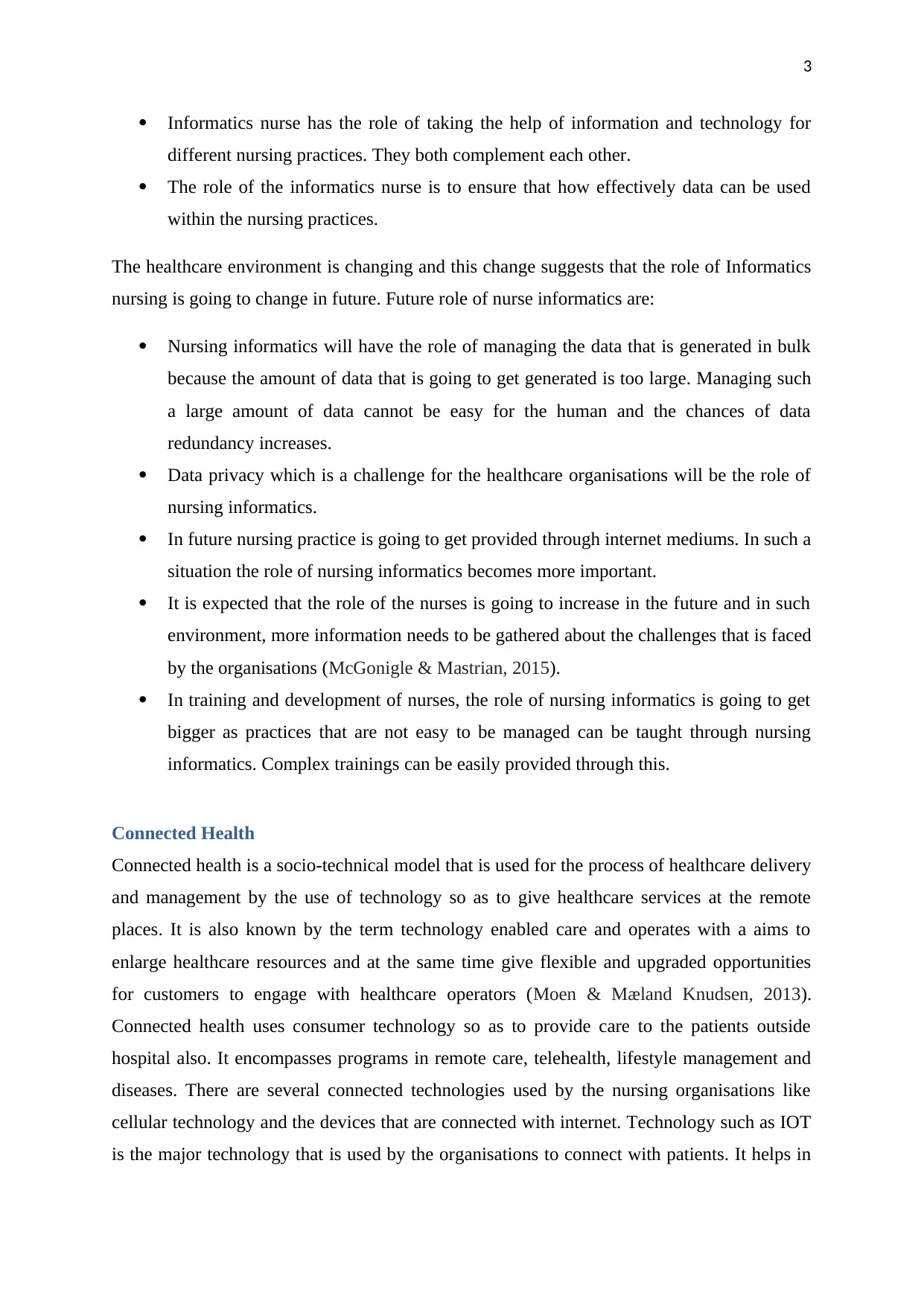
3
Informatics nurse has the role of taking the help of information and technology for
different nursing practices. They both complement each other.
The role of the informatics nurse is to ensure that how effectively data can be used
within the nursing practices.
The healthcare environment is changing and this change suggests that the role of Informatics
nursing is going to change in future. Future role of nurse informatics are:
Nursing informatics will have the role of managing the data that is generated in bulk
because the amount of data that is going to get generated is too large. Managing such
a large amount of data cannot be easy for the human and the chances of data
redundancy increases.
Data privacy which is a challenge for the healthcare organisations will be the role of
nursing informatics.
In future nursing practice is going to get provided through internet mediums. In such a
situation the role of nursing informatics becomes more important.
It is expected that the role of the nurses is going to increase in the future and in such
environment, more information needs to be gathered about the challenges that is faced
by the organisations (McGonigle & Mastrian, 2015).
In training and development of nurses, the role of nursing informatics is going to get
bigger as practices that are not easy to be managed can be taught through nursing
informatics. Complex trainings can be easily provided through this.
Connected Health
Connected health is a socio-technical model that is used for the process of healthcare delivery
and management by the use of technology so as to give healthcare services at the remote
places. It is also known by the term technology enabled care and operates with a aims to
enlarge healthcare resources and at the same time give flexible and upgraded opportunities
for customers to engage with healthcare operators (Moen & Mæland Knudsen, 2013).
Connected health uses consumer technology so as to provide care to the patients outside
hospital also. It encompasses programs in remote care, telehealth, lifestyle management and
diseases. There are several connected technologies used by the nursing organisations like
cellular technology and the devices that are connected with internet. Technology such as IOT
is the major technology that is used by the organisations to connect with patients. It helps in
Informatics nurse has the role of taking the help of information and technology for
different nursing practices. They both complement each other.
The role of the informatics nurse is to ensure that how effectively data can be used
within the nursing practices.
The healthcare environment is changing and this change suggests that the role of Informatics
nursing is going to change in future. Future role of nurse informatics are:
Nursing informatics will have the role of managing the data that is generated in bulk
because the amount of data that is going to get generated is too large. Managing such
a large amount of data cannot be easy for the human and the chances of data
redundancy increases.
Data privacy which is a challenge for the healthcare organisations will be the role of
nursing informatics.
In future nursing practice is going to get provided through internet mediums. In such a
situation the role of nursing informatics becomes more important.
It is expected that the role of the nurses is going to increase in the future and in such
environment, more information needs to be gathered about the challenges that is faced
by the organisations (McGonigle & Mastrian, 2015).
In training and development of nurses, the role of nursing informatics is going to get
bigger as practices that are not easy to be managed can be taught through nursing
informatics. Complex trainings can be easily provided through this.
Connected Health
Connected health is a socio-technical model that is used for the process of healthcare delivery
and management by the use of technology so as to give healthcare services at the remote
places. It is also known by the term technology enabled care and operates with a aims to
enlarge healthcare resources and at the same time give flexible and upgraded opportunities
for customers to engage with healthcare operators (Moen & Mæland Knudsen, 2013).
Connected health uses consumer technology so as to provide care to the patients outside
hospital also. It encompasses programs in remote care, telehealth, lifestyle management and
diseases. There are several connected technologies used by the nursing organisations like
cellular technology and the devices that are connected with internet. Technology such as IOT
is the major technology that is used by the organisations to connect with patients. It helps in
Paraphrase This Document
Need a fresh take? Get an instant paraphrase of this document with our AI Paraphraser
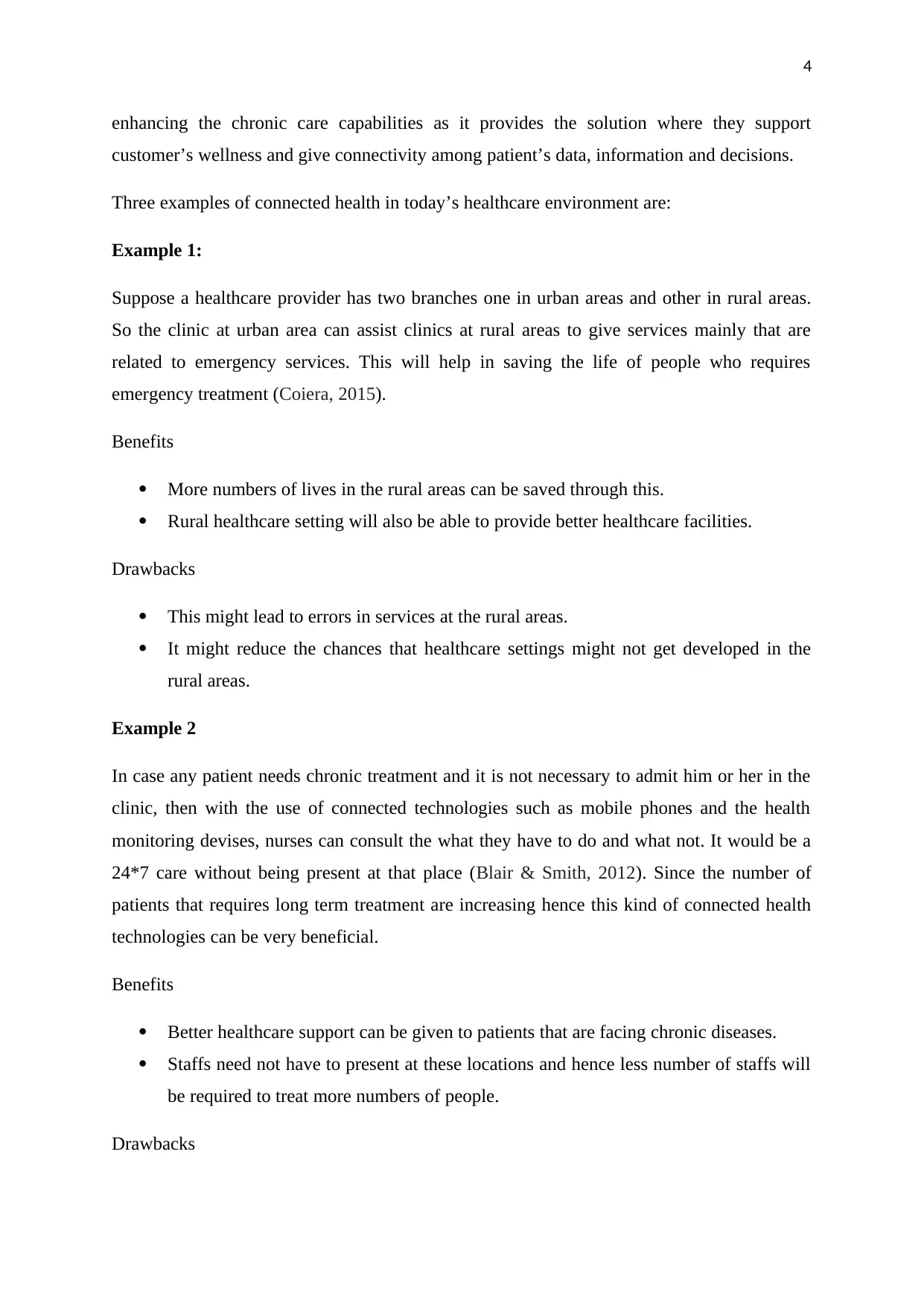
4
enhancing the chronic care capabilities as it provides the solution where they support
customer’s wellness and give connectivity among patient’s data, information and decisions.
Three examples of connected health in today’s healthcare environment are:
Example 1:
Suppose a healthcare provider has two branches one in urban areas and other in rural areas.
So the clinic at urban area can assist clinics at rural areas to give services mainly that are
related to emergency services. This will help in saving the life of people who requires
emergency treatment (Coiera, 2015).
Benefits
More numbers of lives in the rural areas can be saved through this.
Rural healthcare setting will also be able to provide better healthcare facilities.
Drawbacks
This might lead to errors in services at the rural areas.
It might reduce the chances that healthcare settings might not get developed in the
rural areas.
Example 2
In case any patient needs chronic treatment and it is not necessary to admit him or her in the
clinic, then with the use of connected technologies such as mobile phones and the health
monitoring devises, nurses can consult the what they have to do and what not. It would be a
24*7 care without being present at that place (Blair & Smith, 2012). Since the number of
patients that requires long term treatment are increasing hence this kind of connected health
technologies can be very beneficial.
Benefits
Better healthcare support can be given to patients that are facing chronic diseases.
Staffs need not have to present at these locations and hence less number of staffs will
be required to treat more numbers of people.
Drawbacks
enhancing the chronic care capabilities as it provides the solution where they support
customer’s wellness and give connectivity among patient’s data, information and decisions.
Three examples of connected health in today’s healthcare environment are:
Example 1:
Suppose a healthcare provider has two branches one in urban areas and other in rural areas.
So the clinic at urban area can assist clinics at rural areas to give services mainly that are
related to emergency services. This will help in saving the life of people who requires
emergency treatment (Coiera, 2015).
Benefits
More numbers of lives in the rural areas can be saved through this.
Rural healthcare setting will also be able to provide better healthcare facilities.
Drawbacks
This might lead to errors in services at the rural areas.
It might reduce the chances that healthcare settings might not get developed in the
rural areas.
Example 2
In case any patient needs chronic treatment and it is not necessary to admit him or her in the
clinic, then with the use of connected technologies such as mobile phones and the health
monitoring devises, nurses can consult the what they have to do and what not. It would be a
24*7 care without being present at that place (Blair & Smith, 2012). Since the number of
patients that requires long term treatment are increasing hence this kind of connected health
technologies can be very beneficial.
Benefits
Better healthcare support can be given to patients that are facing chronic diseases.
Staffs need not have to present at these locations and hence less number of staffs will
be required to treat more numbers of people.
Drawbacks
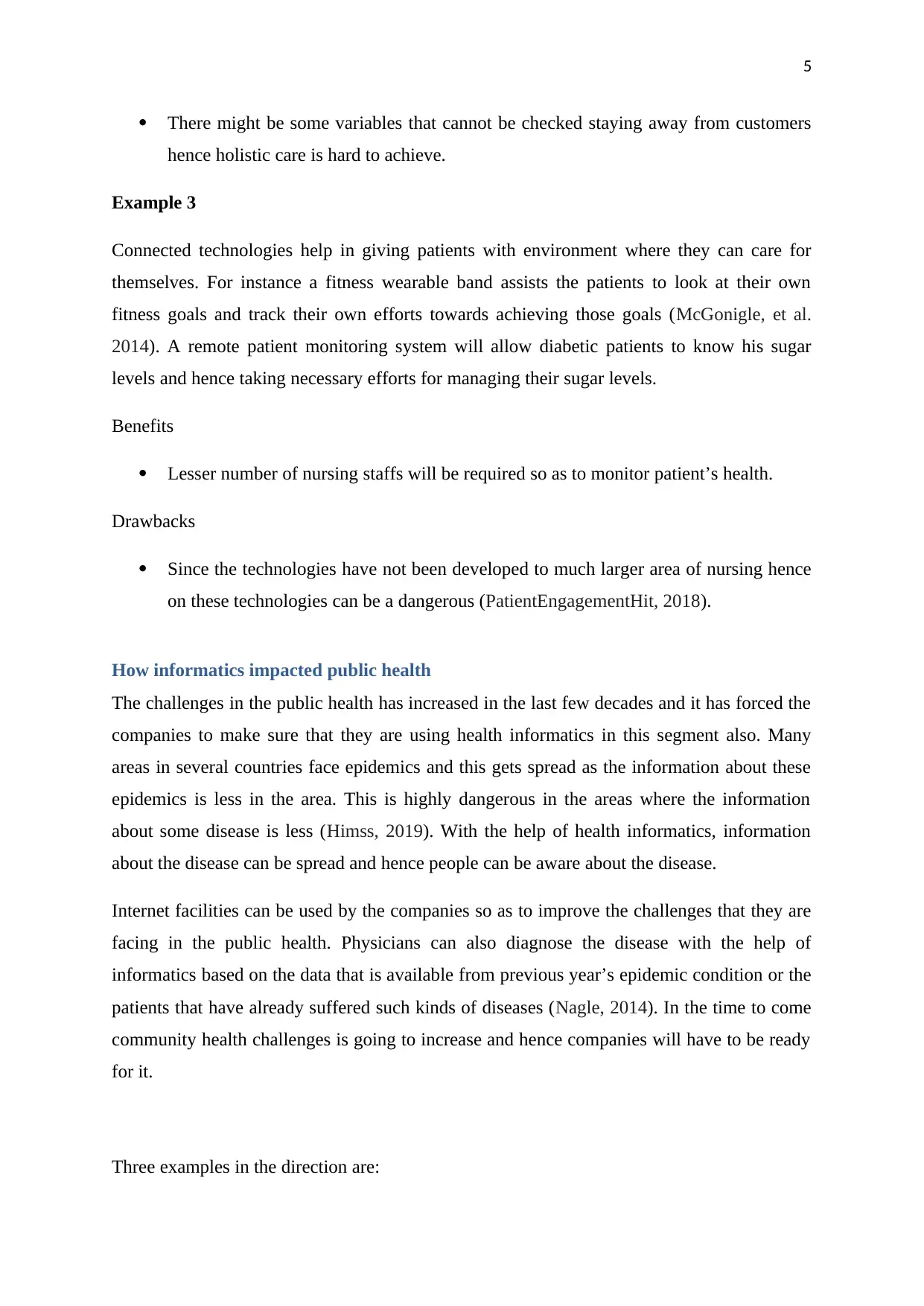
5
There might be some variables that cannot be checked staying away from customers
hence holistic care is hard to achieve.
Example 3
Connected technologies help in giving patients with environment where they can care for
themselves. For instance a fitness wearable band assists the patients to look at their own
fitness goals and track their own efforts towards achieving those goals (McGonigle, et al.
2014). A remote patient monitoring system will allow diabetic patients to know his sugar
levels and hence taking necessary efforts for managing their sugar levels.
Benefits
Lesser number of nursing staffs will be required so as to monitor patient’s health.
Drawbacks
Since the technologies have not been developed to much larger area of nursing hence
on these technologies can be a dangerous (PatientEngagementHit, 2018).
How informatics impacted public health
The challenges in the public health has increased in the last few decades and it has forced the
companies to make sure that they are using health informatics in this segment also. Many
areas in several countries face epidemics and this gets spread as the information about these
epidemics is less in the area. This is highly dangerous in the areas where the information
about some disease is less (Himss, 2019). With the help of health informatics, information
about the disease can be spread and hence people can be aware about the disease.
Internet facilities can be used by the companies so as to improve the challenges that they are
facing in the public health. Physicians can also diagnose the disease with the help of
informatics based on the data that is available from previous year’s epidemic condition or the
patients that have already suffered such kinds of diseases (Nagle, 2014). In the time to come
community health challenges is going to increase and hence companies will have to be ready
for it.
Three examples in the direction are:
There might be some variables that cannot be checked staying away from customers
hence holistic care is hard to achieve.
Example 3
Connected technologies help in giving patients with environment where they can care for
themselves. For instance a fitness wearable band assists the patients to look at their own
fitness goals and track their own efforts towards achieving those goals (McGonigle, et al.
2014). A remote patient monitoring system will allow diabetic patients to know his sugar
levels and hence taking necessary efforts for managing their sugar levels.
Benefits
Lesser number of nursing staffs will be required so as to monitor patient’s health.
Drawbacks
Since the technologies have not been developed to much larger area of nursing hence
on these technologies can be a dangerous (PatientEngagementHit, 2018).
How informatics impacted public health
The challenges in the public health has increased in the last few decades and it has forced the
companies to make sure that they are using health informatics in this segment also. Many
areas in several countries face epidemics and this gets spread as the information about these
epidemics is less in the area. This is highly dangerous in the areas where the information
about some disease is less (Himss, 2019). With the help of health informatics, information
about the disease can be spread and hence people can be aware about the disease.
Internet facilities can be used by the companies so as to improve the challenges that they are
facing in the public health. Physicians can also diagnose the disease with the help of
informatics based on the data that is available from previous year’s epidemic condition or the
patients that have already suffered such kinds of diseases (Nagle, 2014). In the time to come
community health challenges is going to increase and hence companies will have to be ready
for it.
Three examples in the direction are:
⊘ This is a preview!⊘
Do you want full access?
Subscribe today to unlock all pages.

Trusted by 1+ million students worldwide
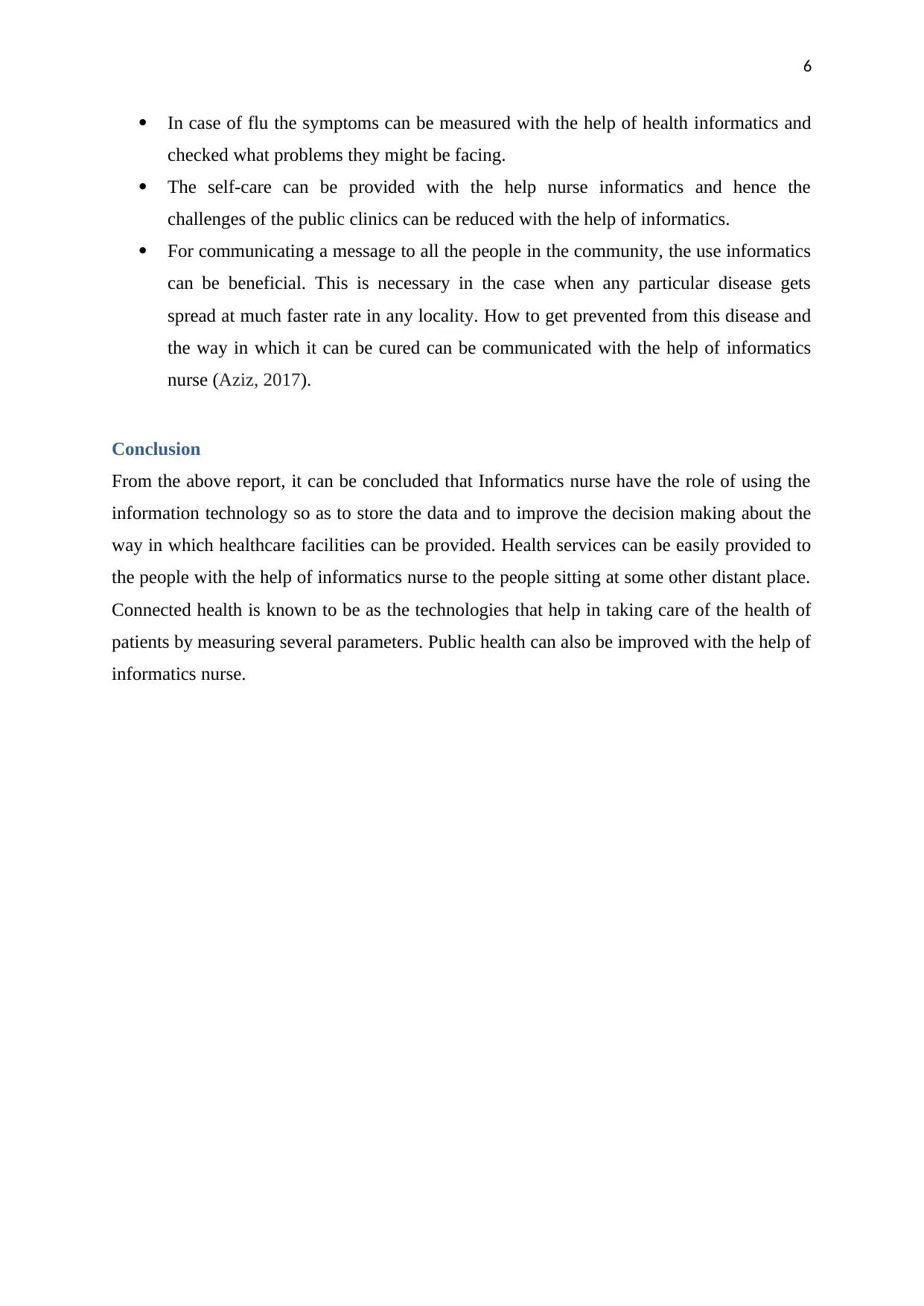
6
In case of flu the symptoms can be measured with the help of health informatics and
checked what problems they might be facing.
The self-care can be provided with the help nurse informatics and hence the
challenges of the public clinics can be reduced with the help of informatics.
For communicating a message to all the people in the community, the use informatics
can be beneficial. This is necessary in the case when any particular disease gets
spread at much faster rate in any locality. How to get prevented from this disease and
the way in which it can be cured can be communicated with the help of informatics
nurse (Aziz, 2017).
Conclusion
From the above report, it can be concluded that Informatics nurse have the role of using the
information technology so as to store the data and to improve the decision making about the
way in which healthcare facilities can be provided. Health services can be easily provided to
the people with the help of informatics nurse to the people sitting at some other distant place.
Connected health is known to be as the technologies that help in taking care of the health of
patients by measuring several parameters. Public health can also be improved with the help of
informatics nurse.
In case of flu the symptoms can be measured with the help of health informatics and
checked what problems they might be facing.
The self-care can be provided with the help nurse informatics and hence the
challenges of the public clinics can be reduced with the help of informatics.
For communicating a message to all the people in the community, the use informatics
can be beneficial. This is necessary in the case when any particular disease gets
spread at much faster rate in any locality. How to get prevented from this disease and
the way in which it can be cured can be communicated with the help of informatics
nurse (Aziz, 2017).
Conclusion
From the above report, it can be concluded that Informatics nurse have the role of using the
information technology so as to store the data and to improve the decision making about the
way in which healthcare facilities can be provided. Health services can be easily provided to
the people with the help of informatics nurse to the people sitting at some other distant place.
Connected health is known to be as the technologies that help in taking care of the health of
patients by measuring several parameters. Public health can also be improved with the help of
informatics nurse.
Paraphrase This Document
Need a fresh take? Get an instant paraphrase of this document with our AI Paraphraser
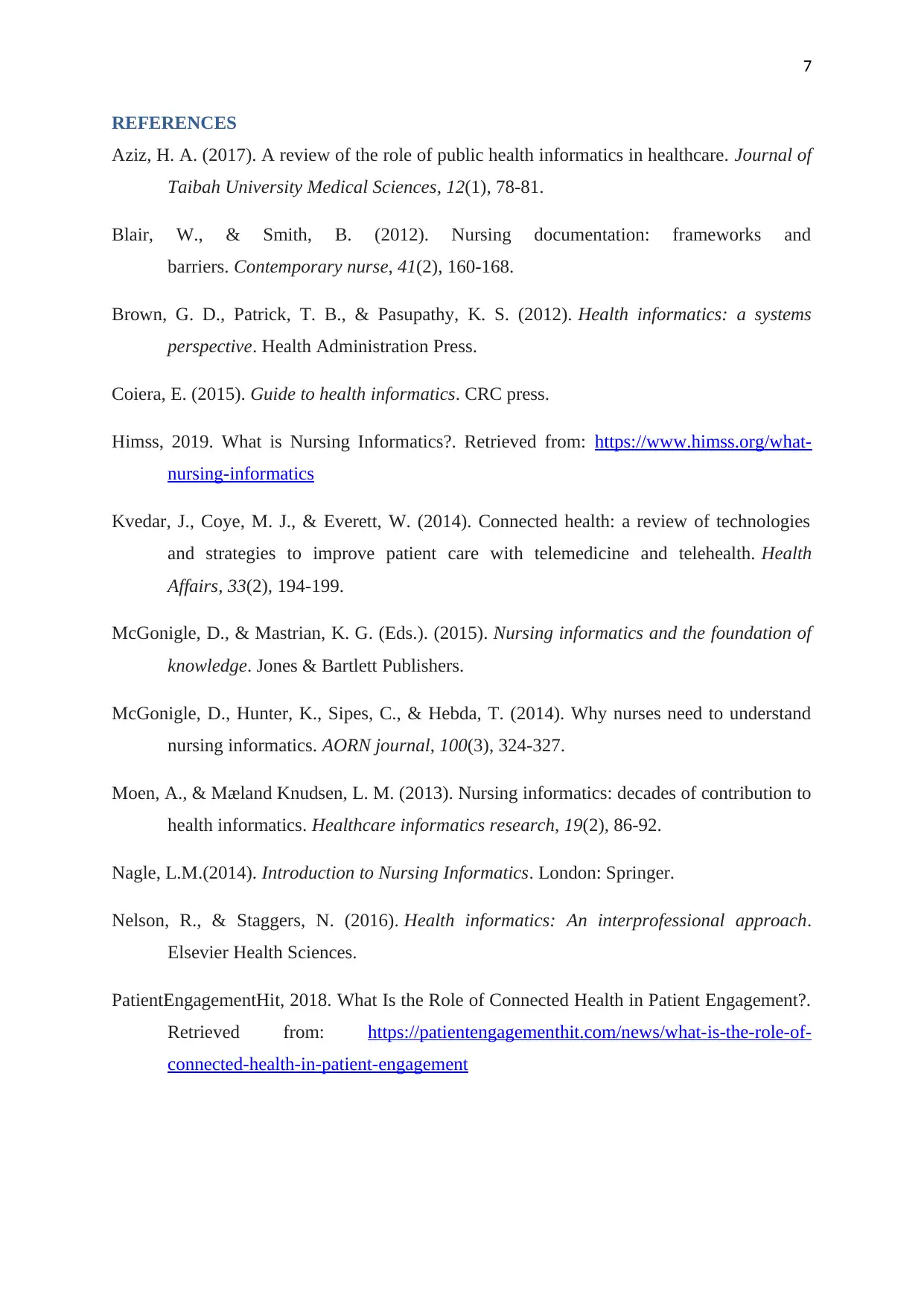
7
REFERENCES
Aziz, H. A. (2017). A review of the role of public health informatics in healthcare. Journal of
Taibah University Medical Sciences, 12(1), 78-81.
Blair, W., & Smith, B. (2012). Nursing documentation: frameworks and
barriers. Contemporary nurse, 41(2), 160-168.
Brown, G. D., Patrick, T. B., & Pasupathy, K. S. (2012). Health informatics: a systems
perspective. Health Administration Press.
Coiera, E. (2015). Guide to health informatics. CRC press.
Himss, 2019. What is Nursing Informatics?. Retrieved from: https://www.himss.org/what-
nursing-informatics
Kvedar, J., Coye, M. J., & Everett, W. (2014). Connected health: a review of technologies
and strategies to improve patient care with telemedicine and telehealth. Health
Affairs, 33(2), 194-199.
McGonigle, D., & Mastrian, K. G. (Eds.). (2015). Nursing informatics and the foundation of
knowledge. Jones & Bartlett Publishers.
McGonigle, D., Hunter, K., Sipes, C., & Hebda, T. (2014). Why nurses need to understand
nursing informatics. AORN journal, 100(3), 324-327.
Moen, A., & Mæland Knudsen, L. M. (2013). Nursing informatics: decades of contribution to
health informatics. Healthcare informatics research, 19(2), 86-92.
Nagle, L.M.(2014). Introduction to Nursing Informatics. London: Springer.
Nelson, R., & Staggers, N. (2016). Health informatics: An interprofessional approach.
Elsevier Health Sciences.
PatientEngagementHit, 2018. What Is the Role of Connected Health in Patient Engagement?.
Retrieved from: https://patientengagementhit.com/news/what-is-the-role-of-
connected-health-in-patient-engagement
REFERENCES
Aziz, H. A. (2017). A review of the role of public health informatics in healthcare. Journal of
Taibah University Medical Sciences, 12(1), 78-81.
Blair, W., & Smith, B. (2012). Nursing documentation: frameworks and
barriers. Contemporary nurse, 41(2), 160-168.
Brown, G. D., Patrick, T. B., & Pasupathy, K. S. (2012). Health informatics: a systems
perspective. Health Administration Press.
Coiera, E. (2015). Guide to health informatics. CRC press.
Himss, 2019. What is Nursing Informatics?. Retrieved from: https://www.himss.org/what-
nursing-informatics
Kvedar, J., Coye, M. J., & Everett, W. (2014). Connected health: a review of technologies
and strategies to improve patient care with telemedicine and telehealth. Health
Affairs, 33(2), 194-199.
McGonigle, D., & Mastrian, K. G. (Eds.). (2015). Nursing informatics and the foundation of
knowledge. Jones & Bartlett Publishers.
McGonigle, D., Hunter, K., Sipes, C., & Hebda, T. (2014). Why nurses need to understand
nursing informatics. AORN journal, 100(3), 324-327.
Moen, A., & Mæland Knudsen, L. M. (2013). Nursing informatics: decades of contribution to
health informatics. Healthcare informatics research, 19(2), 86-92.
Nagle, L.M.(2014). Introduction to Nursing Informatics. London: Springer.
Nelson, R., & Staggers, N. (2016). Health informatics: An interprofessional approach.
Elsevier Health Sciences.
PatientEngagementHit, 2018. What Is the Role of Connected Health in Patient Engagement?.
Retrieved from: https://patientengagementhit.com/news/what-is-the-role-of-
connected-health-in-patient-engagement

8
⊘ This is a preview!⊘
Do you want full access?
Subscribe today to unlock all pages.

Trusted by 1+ million students worldwide
1 out of 9
Related Documents
Your All-in-One AI-Powered Toolkit for Academic Success.
+13062052269
info@desklib.com
Available 24*7 on WhatsApp / Email
![[object Object]](/_next/static/media/star-bottom.7253800d.svg)
Unlock your academic potential
Copyright © 2020–2025 A2Z Services. All Rights Reserved. Developed and managed by ZUCOL.




